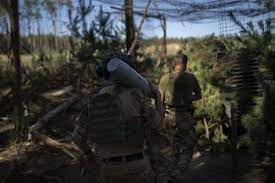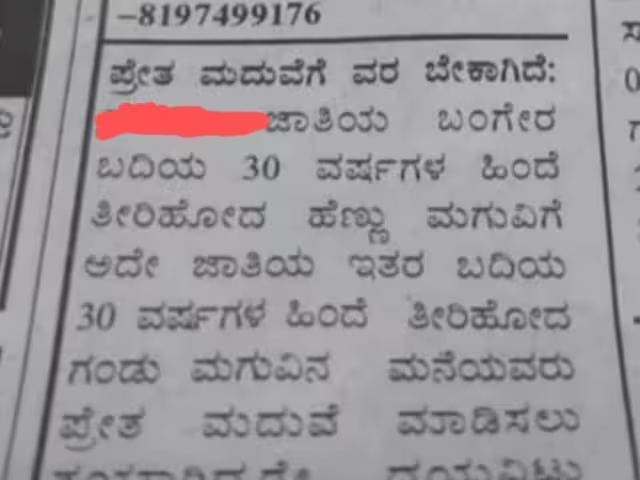Russians pressure Ukraine in the northeast to divert attention from more crucial counteroffensive battles
The muzzle of a Soviet-era howitzer rises from under a canopy of pine trees in the woods of northeast Ukraine, aimed towards a line of advancing Russian infantrymen some distance distant.
A Ukrainian soldier gives the order to fire before quickly running for cover. A shroud of black smoke rises over the lance of yellow flames as a result of the projectile’s deafening collision. Every day, more wasted shells accumulate in the surrounding vegetation.
Moscow’s army is waging a fierce drive here along a short portion of the 1,200-kilometer (745-mile) front line in an effort to stifle Ukrainian forces, divert them from their arduous counteroffensive, and reduce the number of soldiers Kyiv can deploy to more crucial engagements in the south.
The Kremlin strategy poses a risk of significantly slowing the counteroffensive’s progress after it was started roughly three months ago. Time is running out for Ukrainian soldiers, who must strive to make the most of the next few weeks of the summer combat season. Kyiv’s endeavor to retake Russian-occupied territory has resulted in meager advances and terrible casualties.
The military of Ukraine today views Russia’s major attack as taking place in the northeast, more especially close to the town of Kupiansk, in the northern Kharkiv region, and in the forested areas close to Lyman.
Meanwhile, Ukraine’s major offensive operations are concentrated in the south, where they are edging closer to the Sea of Azov’s coasts in an apparent effort to close the land route to the Crimean Peninsula, which Russia annexed in 2014. This would compromise Moscow’s supply routes by dividing the Russian-occupied territory in southern Ukraine in half.
Hanna Maliar, the deputy defense minister, asked onlookers to gauge Ukrainian progress not in terms of distance traveled or elevation gained, but rather “by the very fact that we are successful in moving forward in such conditions.”
According to Ukrainian sources, Russia has had time to strengthen its positions in the south, including laying broad mines, while simultaneously attempting to keep Ukrainian soldiers occupied in the rather stagnant northeast front. Kyiv’s advancements in that direction have been hindered by the extensive fortifications.
The Ukrainians must contend with manpower, air power, and artillery shortages in the meanwhile. Additionally, the approaching autumn rainy season increases the urgency of an already difficult war. The army and heavy equipment of Kiev will be hampered by the muddy terrain.
Ukrainian soldiers have lately had better success penetrating Russian defenses in the south. In the southern Zaporizhzhia area, Ukraine has made 7 kilometers (4.3 miles) of progress since the counteroffensive began. Last week, it overcame strong Russian defenses to recapture the town of Robotyne, marking the nation’s first strategically important win there.
It falls well short of the broad geographical advances that Western allies had anticipated. However, taking control of the settlement moves Ukrainian troops closer to Tokmak, which is a crucial Russian-occupied rail hub and is roughly 30 kilometers (19 miles) away. This would be a significant strategic advantage. Additionally, military experts claim that if Ukrainian forces move even 15 kilometers (9 miles) away from Robotyne, they would come within gunshot distance of Russia’s east-west transit corridors, thus compromising Moscow’s battle readiness.
A Ukrainian soldier stationed in Zaporizhzhia with the call sign “Legion” remarked, “We passed the first line of Russian defense, and we are approaching the second.” He said that NATO-supplied weaponry, in particular Bradley fighting vehicles built in the United States, as well as drones made in Ukraine that could launch attacks from 60 kilometers (37 miles) behind Russian lines were responsible for the victory.
According to military spokesperson Oleksandr Shtupun, the second defensive line is “quite strong” in several areas, notably the Robotyne region. “It is difficult to breach it without proper preparation.”
With the exception of stating that it intends to restore Ukraine’s territorial boundaries from 1991, Kiev has never publicly defined its objectives for the counteroffensive.
Midway through July, Russia expanded its campaign in the northeast and gathered 100,000 soldiers. Where Russian artillery attacked Ukrainian positions in the lush forests close to Lyman, dark patches of burnt trees identify the location. The region that people called the “silver forest” is now a “black forest,” according to soldiers’ jokes.
Near the Synkivka village, where Russian troops have concentrated their offensive, Ukrainian soldiers must proceed across mostly open fields on the outskirts of Kupiansk. As a result of the adjacent villages being destroyed, Ukrainian soldiers had limited alternatives for cover.
Viktor Yurchuk, the brigade artillery commander, reported that the enemy was continually attempting to approach. “There has been nonstop fighting.”
The commander of Ukraine’s ground forces, Col. Gen. Oleksandr Syrskyi, said that Russian forces were reorganizing in the Kupiansk and Lyman regions and deploying freshly created brigades and divisions as well as equipment. According to Maliar, professional airborne forces have also been sent from the area of Avdiivka in the Donetsk region, farther south, where the two armies are now engaged in combat.
A Russian breakthrough in the northeast would not only stop Ukrainian troops from redeploying in the south but also establish a protective buffer for the Kremlin’s supply lines. In Bakhmut, where Kyiv’s soldiers recently grabbed control of commanding heights closer to Russia’s supply lines, Moscow seeks to prevent Ukrainian advances.
That indicates to Yurchuk that the confrontations will not soon become less intense. He is worn out after 18 months of fighting.
Believe me when I say that everyone is tired of the war.
Some of Ukraine’s friends have privately voiced fear that the counteroffensive would not be successful. Soldiers say that every kilometer of progress against a well-equipped foe is a tremendous task.
Jake Sullivan, the national security advisor for the United States, refuted the idea that Ukraine is stuck in a deadlock last week by claiming that Ukrainians “are operating according to their tactics and their timetable.”
Ukrainian troops on the front lines have heard the worries of the allies.
According to a drone operator with the elite Adam Group in the Bakhmut region going by the call sign “Salam,” “it’s very hard for our soldiers to hear that our assault is going too slowly.” We are here to observe the situation on the front lines, and we never anticipated anything to happen quickly.
Many Ukrainian service personnel have this opinion.
Ukrainian Foreign Minister Dmytro Kuleba expressed his irritation last week, saying that criticizing the poor progress is like to “spitting in the face of the Ukrainian soldier who sacrifices his life every day.”
While visiting Spain, he remarked, “I would advise (to) all critics to shut up, come to Ukraine, and try to liberate one square centimeter by themselves.”
An expert at the Institute for the Study of War think tank in the United States, George Barros, disputed claims that the counteroffensive was failing.
Given the manner it was sponsored, this campaign is doing as well as it possibly could, he said.
Even a modest Ukrainian advance that cuts off a key strategic point in Russian lines may leave the Kremlin’s forces “stretched very thin,” according to Barros, who noted that the Russians seem to have little reserve flexibility.
There is yet little evidence that Russia’s northeastern operations are significantly affecting the Ukrainian onslaught in the south.
Before the rains begin, “on time, let’s say we have about one more month,” Shtupun remarked. “I believe that we still have time for offensive measures, just as our adversary does as well.”







